Table of Contents
<!-- Template Revision 1.64 (HTML comments will be not displayed in the document, no need to remove them. For Template/Skeleton changes, increase Template Revision number. So we can check faster, if the TRM style is up to date). --> |
Table of Contents |
Refer to https://wiki.trenz-electronic.de/display/PD/TE0715+TRM for online version of this manual and the rest of available documentation. |
The Trenz Electronic TE0715 is an industrial-grade SoM (System on Module) based on Xilinx Zynq-7000 SoC (XC7Z015 or XC7Z030) with 1GByte of DDR3 SDRAM, 32MBytes of SPI Flash memory, Gigabit Ethernet PHY transceiver, a USB PHY transceiver and powerful switching-mode power supplies for all on-board voltages. A large number of configurable I/Os is provided via rugged high-speed stacking strips.
Industrial-grade Xilinx Zynq-7000 SoC (XC7Z015, XC7Z030)
Additional assembly options are available for cost or performance optimization upon request.
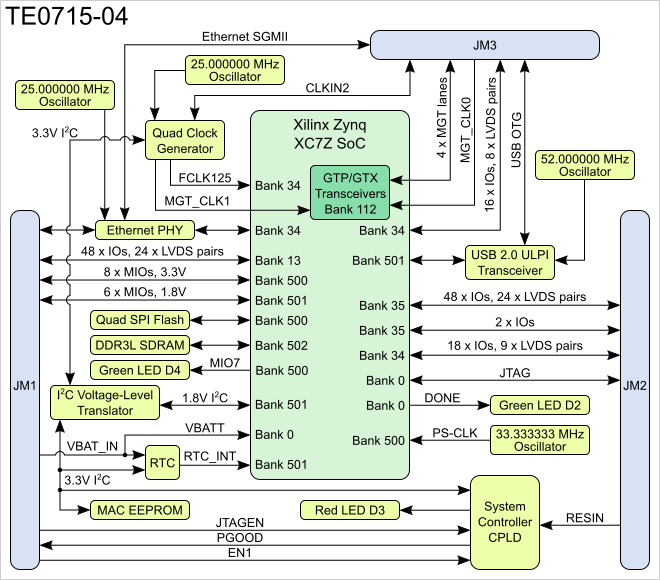
Figure 1: TE0715 block diagram.

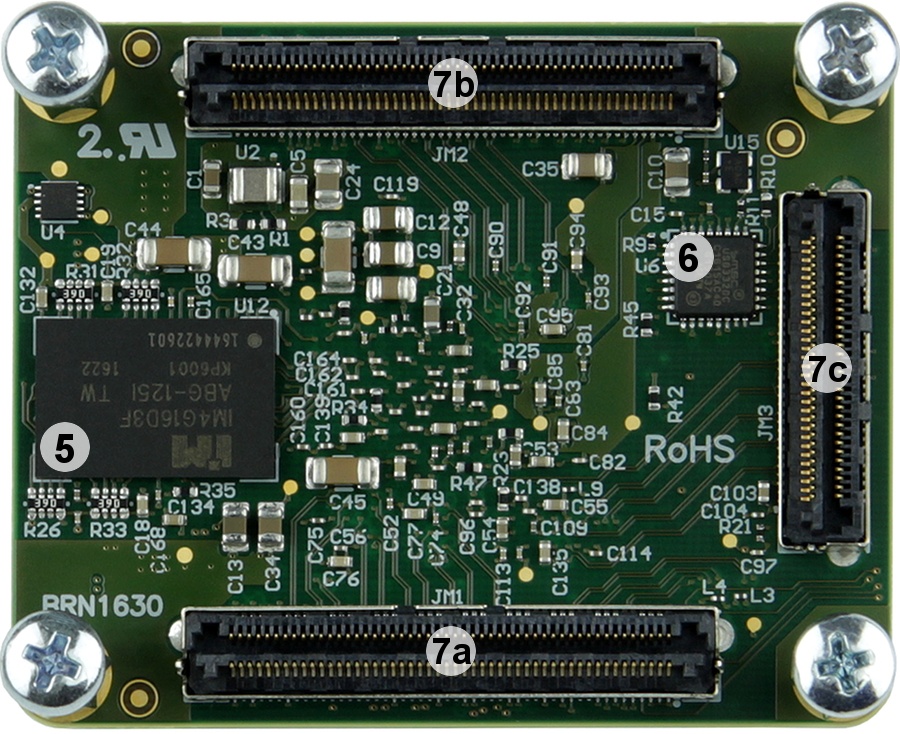
Figure 2: TE0715 main components.
Storage device name | Content | Notes |
|---|---|---|
24AA025E48 EEPROM | User content not programmed | Valid MAC address from manufacturer. |
SPI Flash OTP Area | Empty, not programmed | Except serial number programmed by flash vendor. |
SPI Flash Quad Enable bit | Programmed | - |
SPI Flash main array | Demo design | - |
eFUSE USER | Not programmed | - |
eFUSE Security | Not programmed | - |
| Si5338 OTP NVM | Default settings pre-programmed | OTP not re-programmable after delivery from factory |
Table 1: Initial delivery state of programmable devices on the module.
By default the TE-0715 supports quad SPI and SD Card boot modes which is controlled by the MODE input signal from the B2B JM1 connector.
MODE Signal State | Boot Mode |
|---|---|
High or open | QSPI |
Low or ground | SD Card |
Table 2: Boot MODE signal description.
I/O signals connected to the SoC's I/O bank and B2B connector:
| Bank | Type | B2B Connector | I/O Signal Count | Voltage | Notes |
|---|---|---|---|---|---|
13 | HR | JM1 | 48 | User | Allowed voltage level from 1.2V to 3.3V. |
34 | HR/HP | JM2 | 18 | User |
|
| 35 | HR/HP | JM2 | 50 | User | As above. |
34 | HR/HP | JM3 | 16 | User | As above. |
500 | MIO | JM1 | 8 | 3.3V | - |
501 | MIO | JM1 | 6 | 1.8V | - |
112 | GT | JM3 | 4 lanes | N/A | See also next section MGT Lanes. |
112 | GT CLK | JM3 | 1 differential input | N/A | NB! AC coupling capacitors required on carrier board. |
Table 3: General overview of board to board I/O signals.
For detailed information about the pin-out, please refer to the Pin-out Table.
MGT (Multi Gigabit Transceiver) lane consists of one transmit and one receive (TX/RX) differential pairs, four signals total per one MGT lane. Following table lists lane number, MGT bank number, transceiver type, signal schematic name, board-to-board connector connection and Zynq SoC pin connection:
| Lane | Bank | Type | Signal Name | B2B Pin | Zynq SoC Pin |
|---|---|---|---|---|---|
| 0 | 112 | GTX |
|
|
|
| 1 | 112 | GTX |
|
|
|
| 2 | 112 | GTX |
|
|
|
| 3 | 112 | GTX |
|
|
|
Table 4: MGT lanes overview.
Below are listed MGT bank reference clock sources.
| Clock signal | Bank | Source | FPGA Pin | Notes |
|---|---|---|---|---|
| MGT_CLK0_P | 112 | B2B, JM3-33 | MGTREFCLK0P_112, U9 | Supplied by the carrier board. |
| MGT_CLK0_N | 112 | B2B, JM3-31 | MGTREFCLK0N_112, V9 | Supplied by the carrier board. |
| MGT_CLK1_P | 112 | U10, CLK2A | MGTREFCLK1P_112, U5 | On-board Si5338A. |
| MGT_CLK1_N | 112 | U10, CLK2B | MGTREFCLK1N_112, V5 | On-board Si5338A. |
Table 5: MGT reference clock sources.
JTAG access to the Xilinx Zynq SoC is provided through B2B connector JM2.
JTAG Signal | B2B Connector Pin |
|---|---|
| TMS | JM2-93 |
| TDI | JM2-95 |
| TDO | JM2-97 |
| TCK | JM2-99 |
Table 6: JTAG interface signals.
| JTAGEN pin in B2B connector JM1 should be kept low or grounded for normal operation. |
Special purpose pins are connected to System Controller CPLD and have following default configuration:
| Pin Name | Mode | Function | Default Configuration |
|---|---|---|---|
| EN1 | Input | Power Enable | No hard wired function on PCB, when forced low pulls POR_B low to emulate power on reset. |
| PGOOD | Output | Power Good | Active high when all on-module power supplies are working properly. |
| NOSEQ | - | - | No function. |
| RESIN | Input | Reset | Active low reset, gated to POR_B. |
| JTAGEN | Input | JTAG Select | Low for normal operation. |
Table 7: System Controller CPLD I/O pins.
Quad SPI Flash (U14) is connected to the Zynq PS QSPI0 interface via PS MIO bank 500, pins MIO1 ... MIO6.
| Zynq SoC's MIO | Signal Name | U5 Pin |
|---|---|---|
| 1 | SPI-CS | C2 |
| 2 | SPI-DQ0/M3 | D3 |
| 3 | SPI-DQ1/M1 | D2 |
| 4 | SPI-DQ2/M2 | C4 |
| 5 | SPI-DQ3/M0 | D4 |
| 6 | SPI-SCK | B2 |
Table 8: Quad SPI interface signals and connections.
SD Card interface is connected form the Zynq SoC's PS MIO bank 501 to the B2B connector JM1, signals MIO40 .. MIO45.
On-board Gigabit Ethernet PHY is provided with Marvell Alaska 88E1512 IC (U7). The Ethernet PHY RGMII interface is connected to the Zynq Ethernet0 PS GEM0. I/O voltage is fixed at 1.8V for HSTL signalling. SGMII (SFP copper or fiber) can be used directly with the Ethernet PHY, as the SGMII pins are available on the B2B connector JM3. The reference clock input of the PHY is supplied from an on-board 25.000000 MHz oscillator (U9), the 125MHz output clock signal CLK_125MHZ is connected to the IN5 pin of the PLL chip (U10).
Ethernet PHY connection
| PHY Pin | Zynq PS | Zynq PL | Notes |
|---|---|---|---|
| MDC/MDIO | MIO52, MIO53 | - | - |
| LED0 | - | J3 | Can be routed via PL to any free PL I/O pin in B2B connector. |
| LED1 | - | K8 | Can be routed via PL to any free PL I/O pin in B2B connector. This LED is connected to PL via level-shifter implemented in system controller CPLD. |
| LED2/Interrupt | MIO46 | - | - |
| CONFIG | - | - | By default the PHY address is strapped to 0x00, alternate configuration is possible. |
| RESETn | MIO50 | - | - |
| RGMII | MIO16..MIO27 | - | - |
| SGMII | - | - | Routed to B2B connector JM3. |
| MDI | - | - | Routed to B2B connector JM1. |
Table 9: Ethernet interface.
USB PHY is provided by USB3320 from Microchip. The ULPI interface is connected to the Zynq PS USB0. The I/O Voltage is fixed at 1.8V. The reference clock input of the PHY is supplied from an on-board 52.000000 MHz oscillator (U15).
USB PHY connection
| PHY Pin | ZYNQ Pin | B2B Name | Notes |
|---|---|---|---|
| ULPI | MIO28..39 | - | Zynq USB0 MIO pins are connected to the PHY. |
| REFCLK | - | - | 52.000000 MHz from on board oscillator (U15). |
| REFSEL[0..2] | - | - | Reference clock frequency select, all set to GND selects 52.000000 MHz. |
| RESETB | MIO51 | - | Active low reset. |
| CLKOUT | MIO36 | - | Connected to 1.8V, selects reference clock operation mode. |
| DP, DM | - | OTG_D_P, OTG_D_N | USB data lines. |
| CPEN | - | VBUS_V_EN | External USB power switch active high enable signal. |
| VBUS | - | USB_VBUS | Connect to USB VBUS via a series of resistors, see reference schematics. |
| ID | - | OTG_ID | For an A-device connect to the ground, for a B-device leave floating. |
Table 10: USB interface.
The schematics for the USB connector and required components is different depending on the USB usage. USB standard A or B connectors can be used for host or device modes. A mini-USB connector can be used for USB device mode. A micro-USB connector can be used for device mode, OTG mode or host mode.
On-board I2C devices are connected to the Zynq SoC's PS bank 501 MIO48 (SCL) and MIO49 (SDA) which is configured as I2C1 by default. As bank 501 VCC_MIO1_501 is fixed to 1.8V, there is a bi-directional voltage-level translator used to connect 3.3V I2C slave devices to the bus. Table below lists I2C slave device addresses and functions:
| I2C Device | IC | I2C Slave Address | Notes |
|---|---|---|---|
| 24AA025E48 | U19 | 0x50 | Serial EEPROMs with EUI-48™ node identity. |
| ISL12020M | U16 | 0x6F | Low-power RTC with battery backed SRAM. |
| ISL12020M | U16 | 0x57 | Battery backed SRAM integrated into RTC. |
| SI5338A | U10 | 0x70 | Programmable quad clock generator. |
Table 11: Slave devices connected to the I2C interface.
The System Controller CPLD (U26) is provided by Lattice Semiconductor LCMXO2-256HC (MachXO2 product family). It is the central system management unit with module specific firmware installed to monitor and control various signals of the FPGA, on-board peripherals, I/O interfaces and module as a whole.
TE0715 module has up to 1 GBytes of DDR3L SDRAM arranged into 32-bit wide memory bus. Different memory sizes are available optionally.
On-board quad SPI Flash memory S25FL256S (U14) is used to store initial FPGA configuration. Besides FPGA configuration, remaining free flash memory can be used for user application and data storage. All four SPI data lines are connected to the FPGA allowing x1, x2 or x4 data bus widths. Maximum data rate depends on the selected bus width and clock frequency used.
SPI Flash QE (Quad Enable) bit must be set to high or FPGA is unable to load its configuration from flash during power-on. By default this bit is set to high at the manufacturing plant. |
On-board Gigabit Ethernet PHY (U7) is provided with Marvell Alaska 88E1512. The Ethernet PHY RGMII interface is connected to the Zynq SoC's PS bank 501 pins MIO16 .. MIO27. Reference clock input of the PHY is supplied from the on-board 25.000000 MHz oscillator (U9), the 125MHz output clock signal CLK_125MHZ is connected to the programmable clock generator (U10) pin IN5.
Hi-speed USB ULPI PHY (U6) is provided with USB3320 from Microchip. The ULPI interface is connected to the Zynq SoC's PS bank 501 pins MIO28 .. 39. Reference clock input is supplied from the on-board 52.000000 MHz oscillator (U15).
A Microchip 24AA025E48 EEPROM (U19) is used which contains a globally unique 48-bit node address compatible with EUI-48TM specification. The device is organized as two blocks of 128 x 8-bit memory. One of the blocks stores the 48-bit node address and is write protected, the other block is available for application use. It is accessible through the I2C slave device address 0x50.
An temperature compensated Intersil ISL12020M is used for Real Time Clock (U16). Battery voltage must be supplied to the module from the baseboard. Battery backed registers can be accessed over I2C bus at slave address of 0x6F. General purpose RAM is at I2C slave address 0x57. RTC IC is supported by Linux so it can be used as hwclock device.
There is a Silicon Labs programmable clock generator Si5338A (U10) chip on the module. It's output frequencies can be programmed via the I2C bus, slave device address is 0x70.
| U10 Signal | Default Frequency | Notes |
|---|---|---|
IN1/IN2 | Externally supplied | Needs decoupling on carrier board. |
IN3 | 25.000000 MHz | Reference input clock. |
IN4 | - | Wired to the GND. |
IN5/IN6 | 125 MHz | Ethernet PHY output clock. |
CLK0 A/B | - | Not used, disabled. |
CLK1 A/B | - | Not used, disabled. |
CLK2 A/B | 125 MHz | MGT reference clock 1. |
CLK3A | - | Bank 34 clock input, default disabled, user clock. |
CLK3B | - | Not used, disabled. |
Table 12: Programmable clock generator I/Os.
The module has following reference clock signals provided by on-board oscillators:
| Source | Signal | Frequency | Destination | Pin Name | Notes |
|---|---|---|---|---|---|
| U18 | CLK | 25.000000 MHz | U10 | IN3 | |
| U9 | CLK | 25.000000 MHz | U7 | XTAL_IN | |
| U11 | PS-CLK | 33.333333 MHz | U5 | PS_CLK_500 | Zynq SoC PS subsystem main clock. |
| U15 | CLK | 52.000000 MHz | U6 | REFCLK | USB3320C PHY reference clock. |
Table 13: Reference clock signals.
| LED | Color | Connected to | Description and Notes |
|---|---|---|---|
D2 | Green | DONE | Reflects inverted DONE signal. ON when FPGA is not configured, OFF as soon as PL is configured. This LED will not operate if the SC can not power on the 3.3V output rail that also powers the 3.3V circuitry on the module. |
D3 | Red | SC | System main status LED. |
D4 | Green | MIO7 | User controlled, default OFF (when PS7 has not been booted). |
Table 14: On-board LEDs.
TE0715-xx-30 has several HP banks on B2B connectors. Those banks have maximum voltage tolerance of 1.8V. Please check special instructions for the baseboard to be used with TE0715-xx-30. |
Power supply with minimum current capability of 3A for system startup is recommended. Maximum power consumption of a module mainly depends on the design running on the FPGA. Xilinx provides power estimator excel sheets to calculate power consumption. It is also possible to evaluate the power consumption of the design with Vivado. See also Trenz Electronic Wiki FAQ.
| Power Input Pin | Typical Current |
|---|---|
| VIN | To be determined. |
| 3.3VIN | To be determined. |
Table 15: Typical power consumption.

Figure 3: Module power distribution diagram.
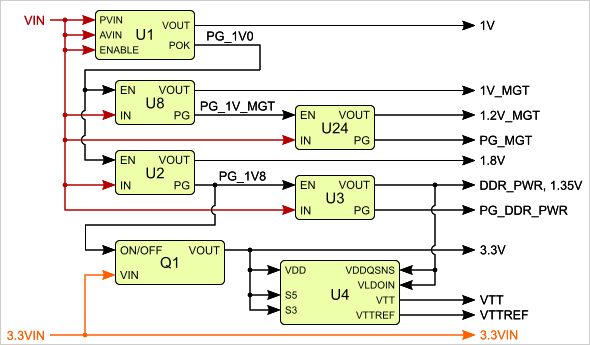
Figure 4: TE0820-02 power-on sequence diagram.
For highest efficiency of the on-board DC-DC regulators, it is recommended to use same 3.3V power source for both VIN and 3.3VIN power rails. Although VIN and 3.3VIN can be powered up in any order, it is recommended to power them up simultaneously.
To avoid any damage to the module, check for stabilized on-board voltages should be carried out (3.3V (JM2-10, 12) or 1.8V(JM1-39) output) before powering up any FPGA's I/O bank voltages VCCO_x. All I/Os should be tri-stated during power-on sequence. |
See Xilinx datasheet DS187 (for XC7Z015) or DS191 (for XC7Z030) for additional information. User should also check related baseboard documentation when choosing baseboard design for TE0715 module.
B2B Name | B2B JM1 Pins | B2B JM2 Pins | Direction | Note |
|---|---|---|---|---|
| VIN | 1, 3, 5 | 2, 4, 6, 8 | Input | Supply voltage. |
| 3.3VIN | 13, 15 | - | Input | Supply voltage. |
| VCCIO13 | 9, 11 | - | Input | High range bank voltage. |
| VCCIO34 | - | 5 | Input | TE0715-xx-15: high range bank voltage. TE0715-xx-30: high performance bank voltage. |
| VCCIO35 | - | 7, 9 | Input | TE0715-xx-15: high range bank voltage. TE0715-xx-30: high performance bank voltage. |
| VBAT_IN | 79 | - | Input | RTC battery-buffer supply voltage. |
| 3.3V | - | 10, 12 | Output | Internal 3.3V voltage level. |
| 1.8V | 39 | - | Output | Internal 1.8V voltage level. |
| DDR_PWR | - | 19 | Output | Internal 1.5V or 1.35V voltage level, depends on revision. |
| VREF_JTAG | 91 | Output | JTAG reference voltage (3.3V). |
Table 16: TE0715 power rails.
Bank | Schematic Name | Voltage | TE0715-xx-15 | TE0715-xx-30 |
|---|---|---|---|---|
| 500 | VCCO_MIO0_500 | 3.3V | - | - |
| 501 | VCCO_MIO1_501 | 1.8V | - | - |
| 502 | VCCO_DDR_502 | 1.5V | - | - |
| 0 Config | VCCO_0 | 3.3V | - | - |
| 13 HR | VCCO_13 | User | HR: 1.2V to 3.3V | HR: 1.2V to 3.3V |
| 34 HR/HP | VCCO_34 | User | HR: 1.2V to 3.3V | HP: 1.2V to 1.8V |
| 35 HR/HP | VCCO_35 | User | HR: 1.2V to 3.3V | HP: 1.2V to 1.8V |
Table 17: TE0715 bank voltages.
| Trenz shop TE0715 overview page | |
|---|---|
| English page | German page |
Table 18: TE0715 variants currently in production.
Parameter | Min | Max | Units | Notes |
|---|---|---|---|---|
VIN supply voltage | -0.3 | 6.0 | V | - |
3.3VIN supply voltage | -0.4 | 3.6 | V | - |
| VBAT supply voltage | -1 | 6.0 | V | - |
| PL IO bank supply voltage for HR I/O banks (VCCO) | -0.5 | 3.6 | V | - |
PL IO bank supply voltage for HP I/O banks (VCCO) | -0.5 | 2.0 | V | TE0715-xx-15 does not have HP banks. |
| I/O input voltage for HR I/O banks | -0.4 | VCCO + 0.55 | V | - |
| I/O input voltage for HP I/O banks | -0.55 | VCCO + 0.55 | V | TE0715-xx-15 does not have HP banks. |
| GT receiver (RXP/RXN) and transmitter (TXP/TXN) | -0.5 | 1.26 | V | - |
Voltage on module JTAG pins | -0.4 | VCCO_0 + 0.55 | V | VCCO_0 is 3.3V nominal. |
Storage temperature | -40 | +85 | °C | - |
| Storage temperature without the ISL12020MIRZ and 88E1512 | -55 | +100 | °C | - |
Table 19: TE0715 module absolute maximum ratings.
| Assembly variants for higher storage temperature range are available on request. |
| Please check Xilinx datasheet DS187 (for XC7Z015) or DS191 (for XC7Z030) for complete list of absolute maximum and recommended operating ratings. |
| Parameter | Min | Max | Units | Notes | Reference Document |
|---|---|---|---|---|---|
| VIN supply voltage | 2.5 | 5.5 | V | ||
| 3.3VIN supply voltage | 3.135 | 3.465 | V | ||
| VBAT_IN supply voltage | 2.7 | 5.5 | V | ||
PL I/O bank supply voltage for HR I/O banks (VCCO) | 1.14 | 3.465 | V | Xilinx datasheet DS191 | |
PL I/O bank supply voltage for HP I/O banks (VCCO) | 1.14 | 1.89 | V | TE0715-xx-15 does not have HP banks | Xilinx datasheet DS191 |
| I/O input voltage for HR I/O banks | (*) | (*) | V | (*) Check datasheet | Xilinx datasheet DS191 or DS187 |
| I/O input voltage for HP I/O banks | (*) | (*) | V | TE0715-xx-15 does not have HP banks (*) Check datasheet | Xilinx datasheet DS191 |
| Voltage on Module JTAG pins | 3.135 | 3.465 | V | VCCO_0 is 3.3 V nominal |
Table 20: TE0715 module recommended operating conditions.
Commercial grade: 0°C to +70°C.
Industrial and extended grade: -40°C to +85°C.
The module operating temperature range depends also on customer design and cooling solution. Please contact us for options.
Module size: 50 mm × 40 mm. Please download the assembly diagram for exact numbers
Mating height with standard connectors: 8mm
PCB thickness: 1.6mm
Highest part on PCB: approx. 2.5mm. Please download the step model for exact numbers
All dimensions are given in millimeters.
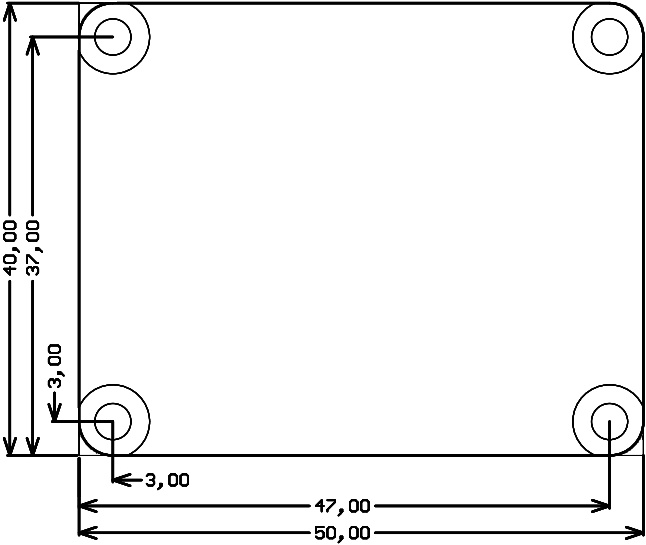
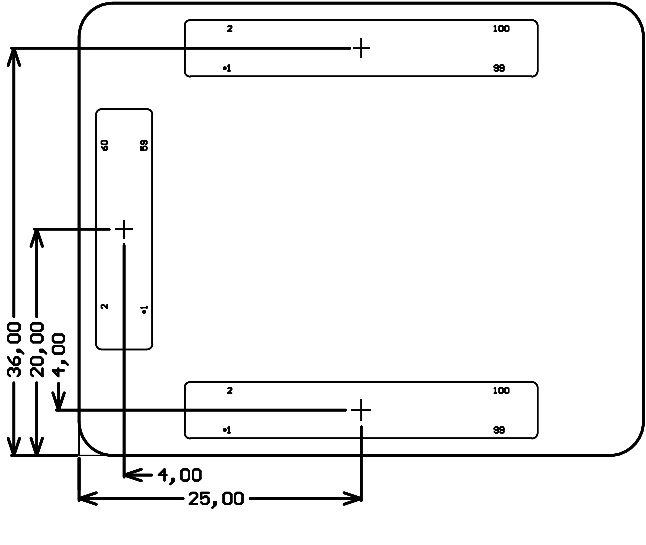
Figure 5: TE0715 physical dimensions.
| Date | Revision | Notes | Link to PCN | Documentation Link |
|---|---|---|---|---|
| 2022-12-21 | 05 | Third production release | TE0715-05 | |
| 2016-06-21 | 04 | Second production release | Click to see PCN | TE0715-04 |
| - | 03 | First production release | TE0715-03 | |
| - | 02 | Prototypes | TE0715-02 | |
| - | 01 | Prototypes |
Table 21: TE0715 module hardware revision history.
Hardware revision number is printed on the PCB board together with the module model number separated by the dash.
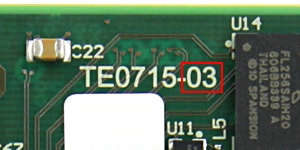
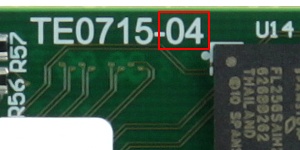
Figure 6: TE0715 hardware revision number.
Date | Revision | Contributors | Description |
|---|---|---|---|
| |||
| 2021-06-21 | v.87 | John Hartfiel |
|
| 2018-07-06 | v.86 | John Hartfiel |
|
2017-11-14 | v.85 | John Hartfiel |
|
| 2017-09-10 | v.82 | Jan Kumann |
|
| 2017-06-07 | v.64 | Jan Kumann |
|
| 2017-03-02 | v.59 | Thorsten Trenz |
|
| 2017-02-10 | v.58 | Thorsten Trenz |
|
| 2017-01-25 | v.55 | Jan Kumann |
|
| 2017-01-14 | v.50 | Jan Kumann |
|
| 2016-11-15 | v.45 | Thorsten Trenz |
|
| 2016-10-18 | v.40 | Ali Naseri |
|
| 2016-06-28 | v.38 | Thorsten Trenz, Emmanuel Vassilakis, Jan Kumann |
|
| 2016-04-27 | v.33 | Thorsten Trenz, Emmanuel Vassilakis |
|
| 2016-03-31 | v.10 | Philipp Bernhardt, Antti Lukats |
|
Table 22: Document change history.